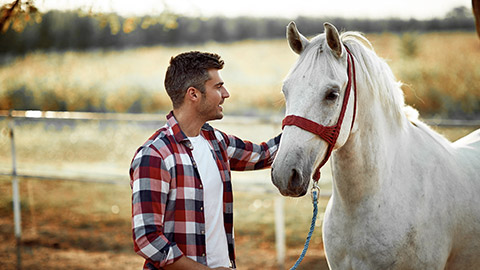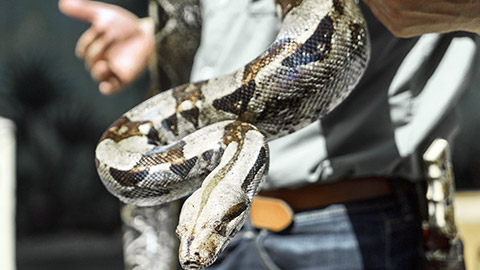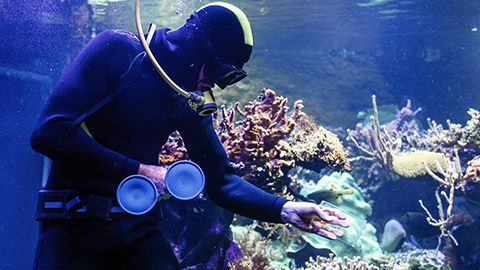Providing enrichment for animals involves offering activities, objects, or environments that stimulate their natural behaviours and enhance their mental and physical well-being. It’s an essential part of animal care, whether in zoos, sanctuaries, shelters, or home environments, and it helps prevent boredom, stress, and the development of negative behaviours.
Enrichment can be broken down into different categories:
1. Physical Enrichment
- Exercise and movement: Providing space or structures like climbing frames, tunnels, or swimming areas that allow animals to exercise naturally.
- Manipulative toys: Items that animals can interact with physically, like balls, chew toys, or puzzle feeders, encourage problem-solving and exploration.
2. Sensory Enrichment
- Visual and auditory stimulation: Objects like mirrors or introducing new sounds (e.g., recordings of nature sounds) keep animals alert and engaged.
- Olfactory enrichment: Scents or treats hidden in their environment encourage natural behaviours like foraging, sniffing, or tracking.
3. Cognitive Enrichment
- Puzzles and challenges: Giving animals tasks that require problem-solving, like treat-dispensing toys, encourages them to think and learn, stimulating their brain.
- Training: Teaching animals new behaviours or tricks engages their mind and helps build positive relationships between the animal and their handler.
4. Social Enrichment
- Interaction with humans or other animals: For social animals, interaction is important. This can mean spending time with other animals or, for some species, positive interaction with humans through petting or play.
5. Feeding Enrichment
-
Variety in diet: Offering different types of food or food presentation methods (like hiding food in puzzles or scatter feeding) mimics natural foraging and hunting behaviours.
- Timed feeding schedules: Changing the timing or method of feeding can keep animals mentally sharp by simulating a more natural feeding process.
Why Enrichment Matters
Enrichment supports the animal’s mental health by offering opportunities to engage in species-specific behaviours like hunting, playing, and exploring. Without it, animals can become bored or stressed, leading to depression, anxiety, or destructive behaviour. Enrichment also contributes to better physical health by encouraging movement and exercise, which reduces obesity and other health issues.
Enrichment- Short Term VS Long Term
Enrichment activities in animal care refer to practices that stimulate animals mentally, physically, and socially to enhance their well-being, reduce stress, and prevent boredom. These activities mimic natural behaviours, promote problem-solving, and encourage animals to interact with their environment in a positive way.
Short Term Enrichment
Short-term enrichment activities provide immediate engagement but typically have a temporary impact. These activities are designed to capture the animal's attention and may only last for a few minutes to hours. They can be easily changed or rotated to maintain interest.
Examples include:
- Providing puzzle feeders or treat-dispensing toys.
- Introducing novel objects, like balls or ropes, for play.
- Offering short social interactions or training sessions.
Long Term Enrichment
Long-term enrichment activities aim for sustained engagement and have a lasting impact on an animal's mental and physical well-being. These activities are often integrated into the animal’s routine and can promote the ongoing development of skills and behaviours. They require more planning and are focused on maintaining the animal's welfare over an extended period.
Examples include:
- Environmental modifications like climbing structures, tunnels, or water features that encourage natural behaviours.
- Social groupings for animals that thrive in companionship ensure long-term bonding.
- Training programs that build complex skills over time and offer regular mental challenges.
- The key difference is that short-term enrichment offers quick but brief stimulation, while long-term enrichment provides lasting effects that support an animal’s overall well-being through continuous interaction and engagement.
Behavioural VS Environment Enrichment
“The purpose of behavioural and environmental enrichment is to improve or enhance the quality of the animal’s environment. The enrichment strategies should allow the animal to demonstrate natural behaviours and should enhance psychological and physiological well-being”
Examples include:
- Scattering worms around the Meerkat enclosure to encourage foraging
- Using a snuffle mat to feed a dog.
- Putting a scratching pole in a cat environment
Types of enrichment include physical, psychological, sensory and social. However, it is important to note that these areas often overlap.

Meet Harry. Harry works on a Horse farm in regional New South Wales.
"As someone who works closely with horses, I ensure they get plenty of enrichment to keep them happy and healthy. Horses are naturally social and curious animals, so I focus on activities that engage their minds and bodies.
One of the main things I do is provide them with plenty of exercise and space to move around. Horses love to roam, graze, and explore, so having large paddocks where they can interact with other horses is important. It keeps them physically active and socially engaged.
For mental stimulation, I use a variety of techniques. One method uses toys like hanging balls or even feeding puzzles that encourage the horses to work for their treats. This mimics some of the challenges they might encounter in the wild, keeping their brains sharp.
I also incorporate sensory enrichment. Horses have strong senses of smell and hearing, so I often introduce new smells, like essential oils or herbs, and change their environment regularly. Even something as simple as moving them to a different paddock or bringing in unfamiliar objects helps keep them curious.
Lastly, I focus on social enrichment. Horses are herd animals, so I always make sure they have companions to interact with. I also spend time grooming and training them, which strengthens our bond and provides positive interaction. The training isn't just about riding and teaching them new commands or tasks, which helps them stay mentally engaged."

Bruce has been a snake handler at a reptile park for several years. His primary role involves ensuring the health, safety, and well-being of the park’s various snake species. While many people don’t immediately think of snakes as needing enrichment, Bruce understands that, like all animals, snakes require mental and physical stimulation to thrive in captivity.
Providing Enrichment: Bruce explains that enrichment for snakes focuses on encouraging their natural behaviours, which include hunting, exploring, and hiding. His approach to enrichment is multifaceted, ensuring that the snakes experience a varied and engaging environment.
Habitat Variation and Exploration:
- "One of the first things I do is change the layout of their enclosures regularly. Snakes are naturally curious and enjoy exploring new surroundings. By adding branches and rocks or even changing the substrate (bedding) they live on, I give them something different to investigate. This mimics their natural environment where they constantly encounter new things in the wild."
- "I also rotate between different hiding spots, giving them places to retreat to. It’s important for snakes to feel secure, so these hiding places reduce stress while encouraging them to explore."
Feeding Enrichment:
- "Snakes are ambush predators, so instead of just giving them their food, I make them work for it. I sometimes hide their food under objects or place it in areas where they have to find it. This stimulates their natural hunting instincts. I also use live food when appropriate, which allows them to engage in the full process of hunting and capturing prey."
- "I switch up feeding times as well because, in the wild, they wouldn’t get food simultaneously every day. By changing the schedule, I prevent them from becoming too used to a routine and keep them more alert."
Sensory Enrichment:
- "Since snakes rely heavily on their sense of smell, I use olfactory enrichment to keep them engaged. Sometimes, I’ll introduce new scents into their environment, like different prey or plants. This encourages them to investigate and use their senses more actively."
- "Temperature plays a big role too. In the wild, snakes move between warm and cool areas to regulate their body temperature. I provide heat gradients in their enclosures so they can choose where they want to be. This not only helps with their physical health but also gives them control over their environment, which is a form of enrichment."
Handling and Interaction:
- "I also believe in interacting with the snakes in a way that doesn’t stress them. Regular handling helps them get used to human contact, which is especially important in a reptile park where visitors may want to learn about them up close. I ensure the handling is gentle and only done when the snakes show signs that they’re comfortable."
- "During interactions, I sometimes introduce different textures or objects for them to explore while being handled. This helps to engage their curiosity and provides them with new experiences."

Millie is a veterinarian working at a busy animal boarding facility that cares for dogs and cats while their owners are away. As a vet, she knows that physical health is closely tied to mental well-being. To keep the animals happy and reduce stress during their stay, Millie strongly emphasises providing consistent enrichment for both species.
Enrichment for Dogs
Physical Activity and Play
- "Dogs are highly energetic animals, and regular exercise is key to keeping them content. We have outdoor play areas where the dogs can run, jump, and interact with one another. Group play sessions allow dogs to socialize, which is especially important for pack animals."
- "For dogs who prefer solo activities or aren’t comfortable in groups, I use toys like balls, frisbees, and tug ropes to engage them in one-on-one play. These sessions not only provide physical exercise but also stimulate their minds."
Puzzle Feeders and Treat Games
- "I often use puzzle feeders during mealtime to add a mental challenge. Dogs have to figure out how to get their food, which mimics problem-solving and hunting behaviours. We also hide treats around the boarding area so they can sniff them out. This engages their powerful sense of smell and keeps them mentally occupied."
Calming Techniques for Anxious Dogs
- "Some dogs can become anxious in a boarding environment. For these dogs, I use calming scents like lavender or chamomile in their bedding, which helps reduce stress. I also provide them with familiar toys or blankets from home, which offers comfort and reduces anxiety."
Enrichment for Cats
Climbing and Exploration
- "Cats are natural climbers and hunters, so we have vertical spaces with shelves and towers for them to climb. This allows them to exercise and observe their environment from different heights, which they enjoy."
- "I also rotate their toys and rearrange the play areas to encourage exploration. Cats love to explore new spaces, and this keeps their environment fresh and stimulating."
Interactive Toys
- "Cats enjoy chasing and stalking, so I provide a variety of interactive toys like laser pointers, feather wands, and motorized toys. These mimic the prey they would hunt in the wild and keep them physically active."
- "For more independent play, I offer toys like balls and tunnels that they can bat around or hide in, which keeps them entertained when I’m not around."
Scent and Sensory Stimulation
- "I use catnip and silvervine to provide scent enrichment for the cats. These scents have a stimulating effect, making them more playful and curious. We also use scratch posts and different textures in their bedding to engage their senses."
- "Some cats are shy, so I create cozy hiding spots with soft blankets, which help them feel safe and secure."
Millie takes a holistic approach to enrichment, recognizing the individual needs of both dogs and cats. By offering a mix of physical activity, mental challenges, and sensory stimulation, she ensures that the animals stay engaged and stress-free during their time at the boarding facility. Whether it’s through social play, interactive toys, or providing calming environments, Millie’s enrichment strategies contribute to the overall well-being of the animals in her care.

At an aquarium, an animal care attendant is responsible for the health and well-being of various aquatic species, including fish, octopuses, and other marine creatures. Unlike mammals, these animals require a specialized approach to enrichment that aligns with their natural environment and behaviours. The attendant’s role is crucial in ensuring these animals are mentally stimulated and engaged in their environment.
Providing Enrichment for Fish
Environmental Complexity and Exploration
- "Fish constantly explore their surroundings, so I focus on creating an environment that mimics their natural habitats. We use a variety of structures, like rocks, plants, and coral formations, which allow the fish to swim through different spaces and interact with their environment."
- "Changing the layout of their habitat periodically keeps things interesting. For example, I might move around some rocks or introduce new plants to give them a new space to explore, which helps stimulate their natural curiosity."
Feeding Enrichment
- "One of the easiest ways to provide enrichment for fish is through feeding techniques. Instead of just dropping food in the water, I scatter it or use slow-release feeders that make the fish ‘hunt’ for their food. This encourages their natural foraging behaviour."
- "For carnivorous species, I sometimes use live prey (such as smaller fish or shrimp) when appropriate, allowing them to practice hunting. This simulates their natural feeding process and keeps them mentally and physically engaged."
Providing Enrichment for Sea Creatures
Interactive Toys and Objects for Octopuses and Cephalopods
- "Octopuses and other cephalopods are incredibly intelligent creatures. To engage their minds, I use interactive toys like puzzle feeders. For instance, I’ll hide their food inside a jar or under a shell, and they must figure out how to access it."
- "I also provide them with different textured objects and toys to manipulate. Octopuses have a strong sense of touch, and giving them things to grab, pull, or push around stimulates their senses."
Sensory and Visual Stimulation
- "For sea creatures like rays and sharks, sensory enrichment plays a big role. We vary the lighting and water flow in their tanks to mimic the changing environment they would experience in the wild. This helps them stay alert and responsive to changes in their surroundings."
- "I also use visual enrichment for creatures like cuttlefish by introducing mirrors or reflective surfaces into their tanks. These creatures are highly visual and will react to their reflections, which encourages exploration and interaction."
Varied Social Enrichment
- "For social species, like schooling fish or rays, interaction with other animals is a key part of their enrichment. I ensure their tank mates are compatible and create an environment where they can exhibit natural social behaviours, like schooling, playing, or engaging in dominance hierarchies."
- "When necessary, I rotate animals between different tanks to provide them with new social dynamics or environments. This helps to prevent boredom and encourages natural social interactions."
The animal care attendant at the aquarium prioritizes creating an enriching environment for both fish and sea creatures. By offering opportunities for exploration, using feeding techniques that encourage natural behaviours, and providing sensory and social stimulation, the attendant ensures that the animals are mentally and physically engaged. These enrichment practices not only improve the animal's quality of life but also help to maintain their overall health in a captive setting.
